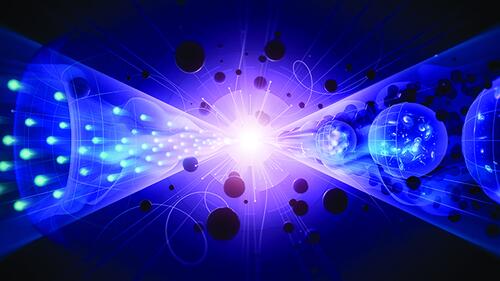
A new report suggesting national particle physics priorities for the next decade and beyond includes an array of Yale research efforts.
On December 8, the High Energy Physics Advisory Panel (HEPAP)–a high-level advisory group to the U.S. Department of Energy (DOE) and the National Science Foundation (NSF)–approved a new set of strategic funding priorities related to particle physics research at an event in Washington, D.C. that included leading physicists from across the nation, including two from Yale’s Wright Lab. Yale Physics’ research and leadership in initiatives identified by the plan aligns strongly with the plan’s goals.
The plan, titled “Exploring the Quantum Universe: Pathways to Innovation and Discovery in Particle Physics” was developed by the Particle Physics Project Prioritization Panel (P5), a subpanel of HEPAP that develops a long-term strategic plan every 8 to 10 years. (The last P5 report was issued in 2014.) Karsten Heeger, the Eugene Higgins Professor of Physics, chair of physics, and director of Wright Lab, is deputy chair of the P5 panel; and Sarah Demers, professor of physics, is a P5 panel member.
Heeger said the P5 report is a 10-year strategic plan with a 20-year vision for U.S. particle physics research. “The panel thought about where the next big discoveries might lie and how we could maximize impact within budget, to support future discoveries and the next generation of researchers and technical workers who will be needed to achieve them,” Heeger said.
P5 Recommendations
The panel identified three main scientific themes in its report: decoding the quantum realm, revealing new knowledge about the hidden universe at a cosmological level, and exploring new scientific paradigms emerging from the intersection of quantum and cosmological research.
Among the report’s specific recommendations are the completion of construction projects and ongoing experiments at the Large Hadron Collider (LHC) at CERN, in Switzerland; the CMB-S4 network of ground-based telescopes observing the cosmic wave background; the Deep Underground Neutrino Experiment (DUNE) and the muon-to-electron conversion experiment (Mu2e) at Fermilab in Illinois; the expansion of the South Pole neutrino observatory IceCube-Gen2; and the Vera C. Rubin Observatory in Chile.
“Yale and its faculty from the Department of Physics has leadership activity in key areas of this plan,” Heeger said. “We have a strong, vibrant program in particle physics.”
Demers added, “There are so many compelling scientific questions that we want to pursue, and so many good ideas about technologies and facilities that would open up new lines of inquiry, that it was a challenge to work within the budget profiles provided by the Department of Energy”.
Demers continued, “We converged on a portfolio of projects that will let us investigate neutrinos, the Higgs boson, dark matter, the accelerating expansion of the universe, new accelerator and detector technologies, and more. . . We have deep involvement in a lot of this work at Yale, so it is going to be an exciting decade.”
P5 at Wright Lab
Five of the experiments mentioned in the report involve the Wright Lab research community and facilities.
- Professors Keith Baker, Sarah Demers, and Paul Tipton have had longstanding roles in the ATLAS experiment at CERN’s Large Hadron Collider, exploring the secrets of the Higgs boson and challenging standard models of physics.
- Demers is developing the trigger and data acquisition system and installing detector electronics for Mu2e to probe physics beyond the frontier of the field’s current “Standard Model.”
- Professor Reina Maruyama is a major contributor to ongoing science at the IceCube experiment, investigating the nature of neutrinos and dark matter.
- Assistant professor Laura Newburgh is pursuing the study of cosmic evolution with CMB-S4, and developing control and data acquisition software for the telescopes.
- Heeger’s group is constructing key instrumentation for the DUNE experiment at Wright Lab.
The technical infrastructure and research facilities at Wright Lab have been key to the development of detector components and upgrades for both ATLAS and DUNE.
In addition to the Wright Lab involvement described above, Yale Physics professor Larry Gladney, who is also Yale’s Phyllis A. Wallace Dean of Diversity and Faculty Development, has a leadership role at the Rubin Observatory’s Legacy Survey of Space and Time (LSST); professor Priyamvada Natarajan uses galaxy clusters as gravitational lenses to probe the nature of the fundamental forces and particles that constitute the building blocks of the universe with a focus on the elucidation of dark matter; and Yale Physics professors Tom Appelquist, Walter Goldberger, Ian Moult, David Poland, and Witold Skiba all contribute to leading research in high energy theory.
P5 in society
The P5 report also recommended that the U.S. invest in initiatives aimed at developing the skilled workforce that will be needed for new technologies that may emerge from the next generation of particle physics research. Discoveries in previous eras have led to manufacturing opportunities and new jobs in industries as varied as telecommunications, medical products, personal electronics, and the financial sector.
“In putting together our report, we thought about the science, of course, but also about the societal impact,” Heeger said. “There are direct benefits to our society that come out of physics research, everything from gaining a deeper understanding of who we are in the context of the universe, to new technologies. And all of this provides a training ground for a highly skilled workforce going forward.”
This article has been adapted from an article by Jim Shelton; originally published in Yale News on December 11, 2023.

